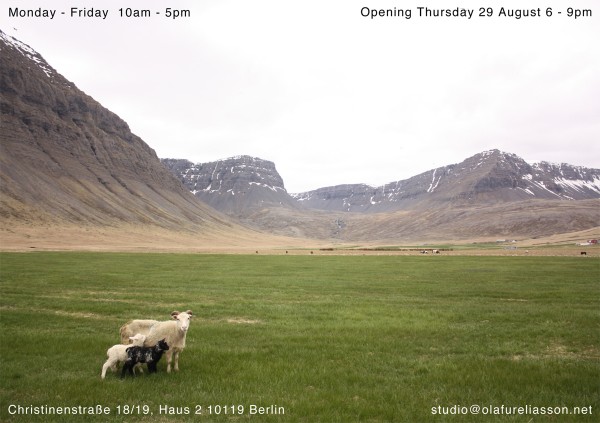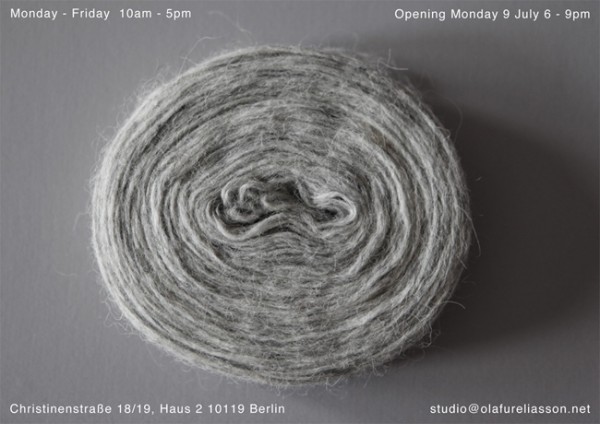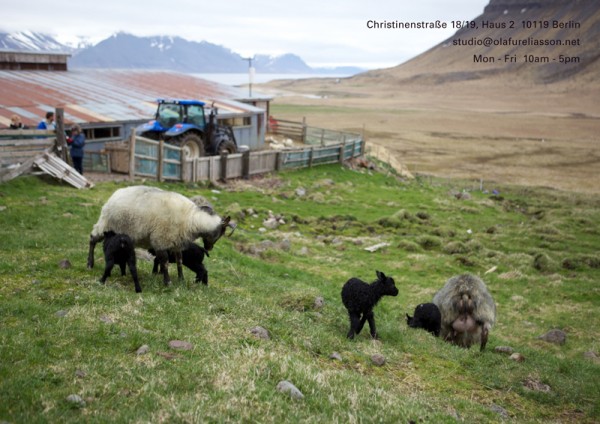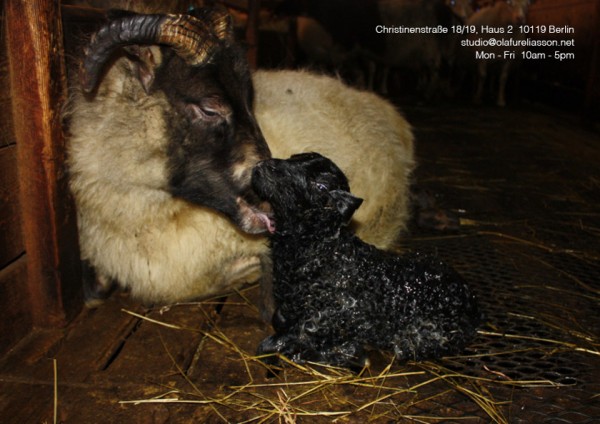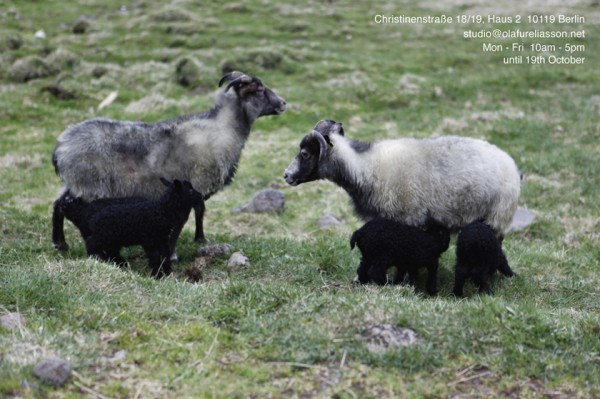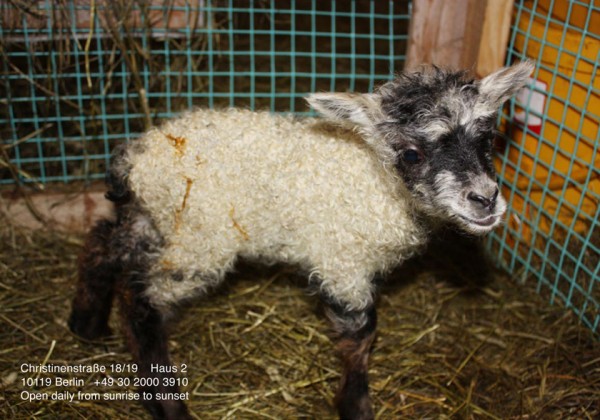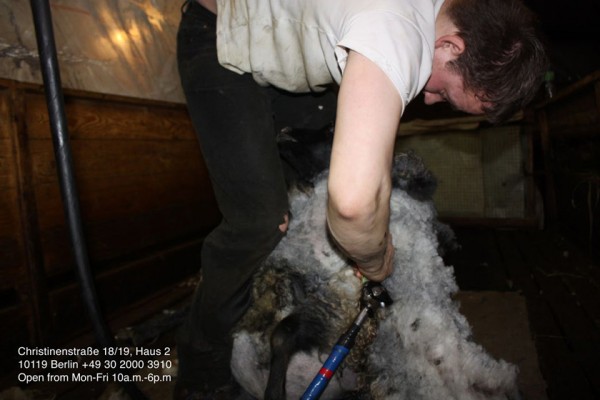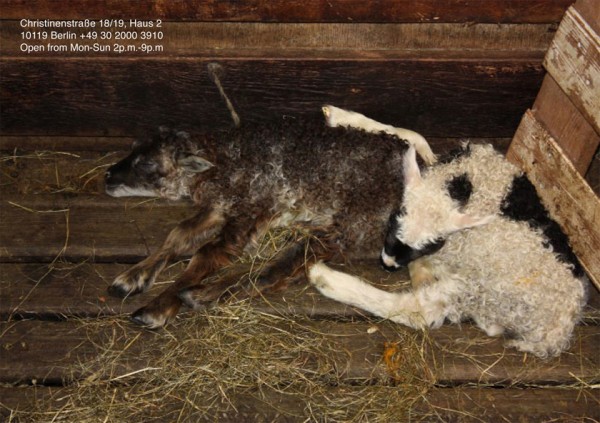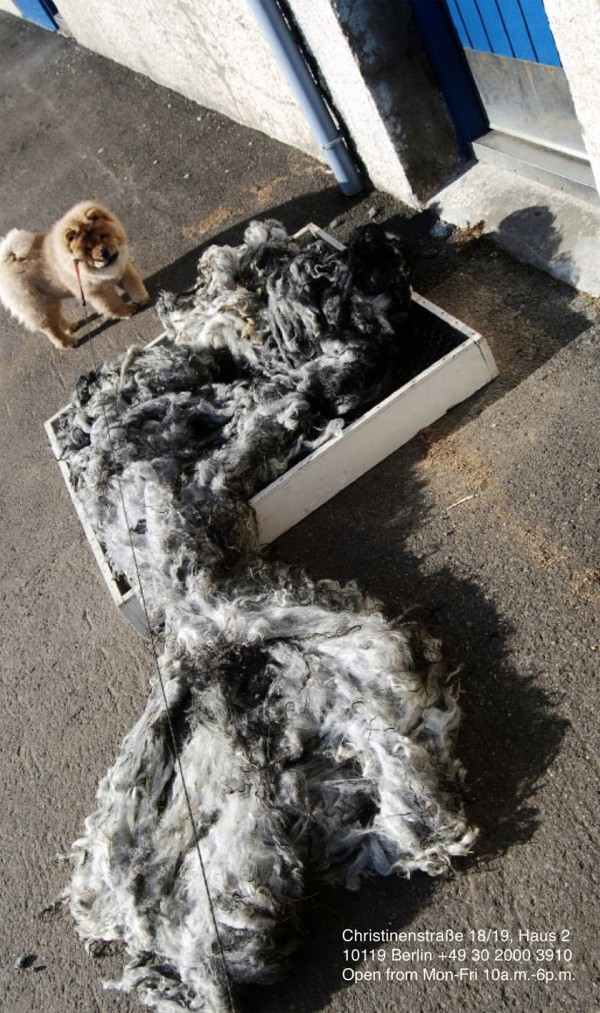06 November 2014 - 09 January 2015 / Exhibition ⟶
Grey Sheep Exhibition Series
Grey Sheep is an ongoing project, initiated by Studio Olafur Eliasson, which expands the studio’s activities by instigating a dialogue between artists associated with the studio or the Institut für Raumexperimente and a local audience. The name refers to a rare type of Icelandic sheep.
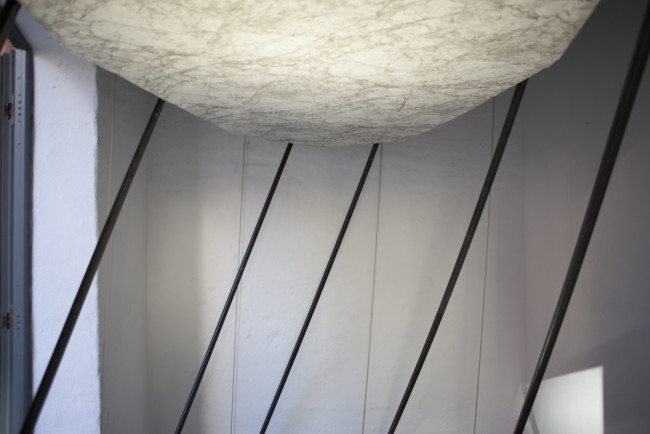
Elise Eeraerts: Complementary Volumes
In complementary volumes, the dimensions of two spatial components are determined by one another’s presence. A large, opaque object is supported by a frame surrounding it, and the volume of the frame is in turn dependent on and defined by the presence of the object inside. Thus, both components balance each other in a tension that is immediately palpable to the visitor.
In complementary volumes, the dimensions of two spatial components are determined by one another’s presence. A large, opaque object is supported by a frame surrounding it, and the volume of the frame is in turn dependent on and defined by the presence of the object inside. Thus, both components balance each other in a tension that is immediately palpable to the visitor.
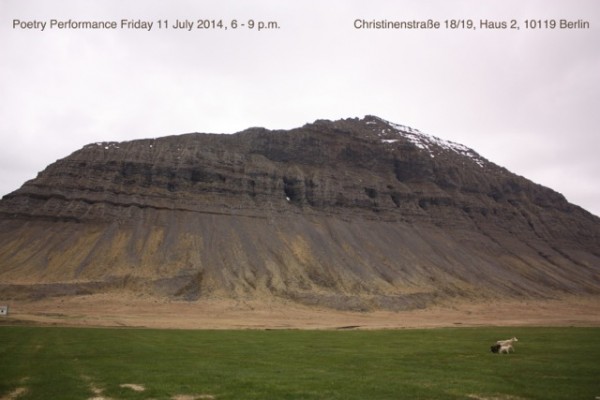
Mihret Kebede, Abebaw Melaku, Jorga Mesfin, Misrak Terefe & Eric Ellingsen: A-B-A-B-A : from here to hear
“Half a-gap half-firmed
superficially locked.
Who shall enter this door?”
Poetry Performance on Friday, 11 July 2014
—
Mihret Kebede is an artist, poet and a founding director of Netsa art village, an artists’ collective. She is also a founding member of Tobiya Poetic Jazz Group since 2008 and is featured on the Tobiya poetry & Jazz DVD, Vol.1 release. She is highly regarded for her poetry readings and experimental artworks.
Abebaw Melaku is a renowned poet and journalist. He is a founding member of Tobiya Poetic Jazz Group since 2008 as well as a radio journalist on the influential Ethiopian radio show, “Addis Zema”. He has published a poetry book called “Keradion” in 2007 and an audio poetry CD in 2008.
Jorga Mesfin is a musician with influences that span the spirit and innovation of Jazz and the ancient and diverse sounds found in Ethiopian music. He has performed with Takana Miyamoto, Aster Aweke, Mahmoud Ahmed and Mulatu Astatke, amongst others. He is the founder of Ethio-jazz group Wudasse, and composed the score to Haile Gerima’s epic Ethiopian movie Teza, for which he won the award for Best Music Selection at the 22nd Carthage Film Festival and Best Composer Award at the 5th Dubai International Film Festival.
Misrak Terefe is a renowned poet in Ethiopia who has published the first poetry VCD as a female poet. She has contributed to different group publications with other writers and is featured on the Tobiya poetry & Jazz DVD, Vol.1 release. She is also a founding member of Tobiya Poetic Jazz Group since 2008.
—
This event is part of Acting Archives, a project by the Institut für Raumexperimente, Berlin University of the Arts and the Alle School of Fine Arts and Design, Addis Ababa University, supported by Studio Olafur Eliasson, and funded by the TURN Fund of the German Federal Cultural Foundation. It is choreographed by Christina Werner and Eric Ellingsen.
“Half a-gap half-firmed
superficially locked.
Who shall enter this door?”
Poetry Performance on Friday, 11 July 2014
—
Mihret Kebede is an artist, poet and a founding director of Netsa art village, an artists’ collective. She is also a founding member of Tobiya Poetic Jazz Group since 2008 and is featured on the Tobiya poetry & Jazz DVD, Vol.1 release. She is highly regarded for her poetry readings and experimental artworks.
Abebaw Melaku is a renowned poet and journalist. He is a founding member of Tobiya Poetic Jazz Group since 2008 as well as a radio journalist on the influential Ethiopian radio show, “Addis Zema”. He has published a poetry book called “Keradion” in 2007 and an audio poetry CD in 2008.
Jorga Mesfin is a musician with influences that span the spirit and innovation of Jazz and the ancient and diverse sounds found in Ethiopian music. He has performed with Takana Miyamoto, Aster Aweke, Mahmoud Ahmed and Mulatu Astatke, amongst others. He is the founder of Ethio-jazz group Wudasse, and composed the score to Haile Gerima’s epic Ethiopian movie Teza, for which he won the award for Best Music Selection at the 22nd Carthage Film Festival and Best Composer Award at the 5th Dubai International Film Festival.
Misrak Terefe is a renowned poet in Ethiopia who has published the first poetry VCD as a female poet. She has contributed to different group publications with other writers and is featured on the Tobiya poetry & Jazz DVD, Vol.1 release. She is also a founding member of Tobiya Poetic Jazz Group since 2008.
—
Eine Veranstaltung im Rahmen von Acting Archives, einem Projekt des Instituts für Raumexperimente der Universität der Künste Berlin und der Alle School of Fine Arts and Design, Addis Ababa University, unterstützt durch Studio Olafur Eliasson, gefördert im Fonds TURN der Kulturstiftung des Bundes. Die Veranstaltung ist choreographiert von Christina Werner und Eric Ellingsen.
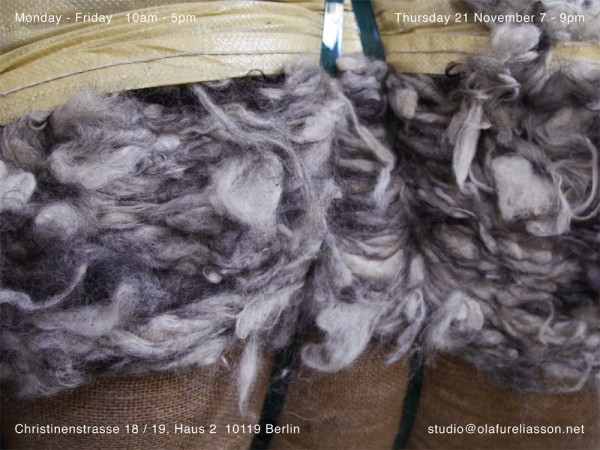
Aeaeaeae, Hans-Henning Korb, Robert Lippok & Raul Walch: Molding versions into reality
Everything is knot together here. Everything hanging here comes from Ethiopia, even the things that come from China, and this is reality. This is the sound of reality snared and knotted together from stories and streets and markets and roundabouts in Addis Ababa. This is archives opposite, a moment of chaotic similarities.
Aeaeaeae, Hans-Henning Korb, Robert Lippok & Raul Walch
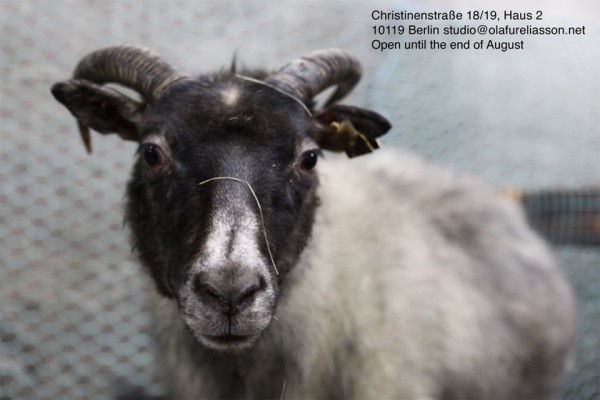
Quynh Vantu, Leon Eixenberger, Clara Jo, Jeremias Holliger, Raul Walch, Asako Iwama & Lauren Maurer
Fresh herbs and seasonal vegetables harvested by Asako Iwama & Lauren Maurer
Leon Eixenberger
Quynh Vantu
Quynh Vantu: Ease Labyrinth
Quynh Vantu: Ease Labyrinth
Jeremias Holliger
Jeremias Holliger
Fresh herbs and seasonal vegetables harvested by Asako Iwama & Lauren Maurer
Leon Eixenberger
Quynh Vantu
Quynh Vantu: Ease Labyrinth
Quynh Vantu: Ease Labyrinth
Jeremias Holliger
Jeremias Holliger
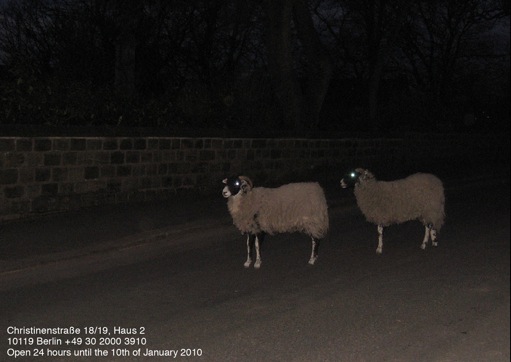
Euan Williams: Turning Shadow into Transient Sight
It’s winter, it’s night, it’s cold.
A group of people are huddled outside around the bay windows of a room – trying to see what it is they are supposed to be looking at. Patience is a large part of the piece. Some give up and look away; others persist – noses pressed against the glass, hands cupped and held to their heads like brackets containing eyes.
In a 100th of a second the large strobe that is inside the room under the window flashes 1500 Joules of light into the space and against the walls – the walls then reflect the light towards the window, to the group of people, and out into the Pfefferberg yard.
In the night time the light is quite aggressive – claiming the area lit up by the flash – burning an impression of the room onto retinas. The walls within the space have been altered – each has a different shade of grey and there are thick black lines along the corners of the walls, ceiling and floor. The group walk away – taking the room with them as an afterimage – a transposed sight overlaid upon a new environment.
During the daytime the flash remains flashing but its intensity is weakened by the light of the sun. The tempo of the pauses in-between each flash varies from day to day – yet always remains slow and disparate from one another.
The flash flashed for 24 hours a day for two months and ran over the winter solstice.
It’s winter, it’s night, it’s cold.
A group of people are huddled outside around the bay windows of a room – trying to see what it is they are supposed to be looking at. Patience is a large part of the piece. Some give up and look away; others persist – noses pressed against the glass, hands cupped and held to their heads like brackets containing eyes.
In a 100th of a second the large strobe that is inside the room under the window flashes 1500 Joules of light into the space and against the walls – the walls then reflect the light towards the window, to the group of people, and out into the Pfefferberg yard.
In the night time the light is quite aggressive – claiming the area lit up by the flash – burning an impression of the room onto retinas. The walls within the space have been altered – each has a different shade of grey and there are thick black lines along the corners of the walls, ceiling and floor. The group walk away – taking the room with them as an afterimage – a transposed sight overlaid upon a new environment.
During the daytime the flash remains flashing but its intensity is weakened by the light of the sun. The tempo of the pauses in-between each flash varies from day to day – yet always remains slow and disparate from one another.
The flash flashed for 24 hours a day for two months and ran over the winter solstice.
